Experience with STMicroelectronics
STMicroelectronics has one of the broadest ranges of semiconductor devices on the market, and DiMonte Group engineers have experience with a wide variety of them. Especially the STM32 series of ARM® Cortex® microcontrollers; 32-bit processors with price points competitive with older 8-bit devices. Here are some examples of some of the designs we have worked on:
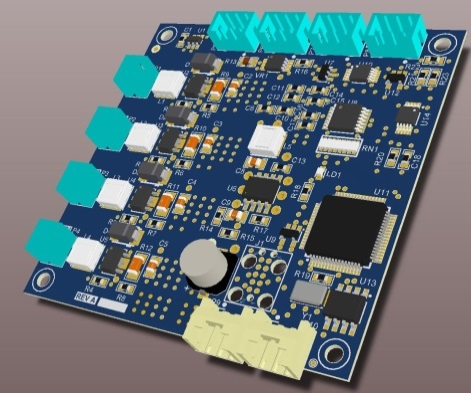
4-Channel Optical Signal Possessor
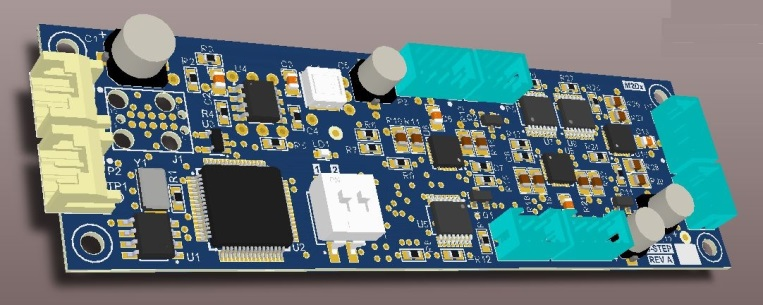
3-Channel Stepper Motor Driver
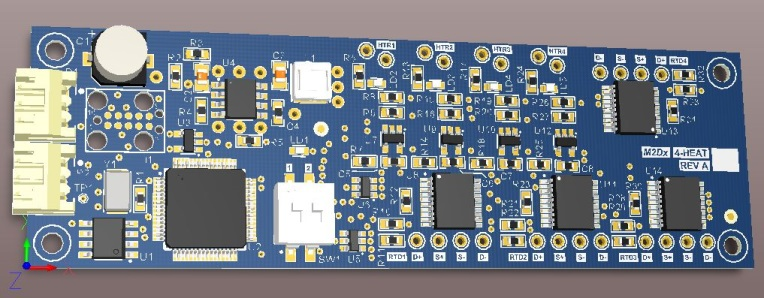
4-Channel Thermal Controller

Battery-Operated Power Tool Controller
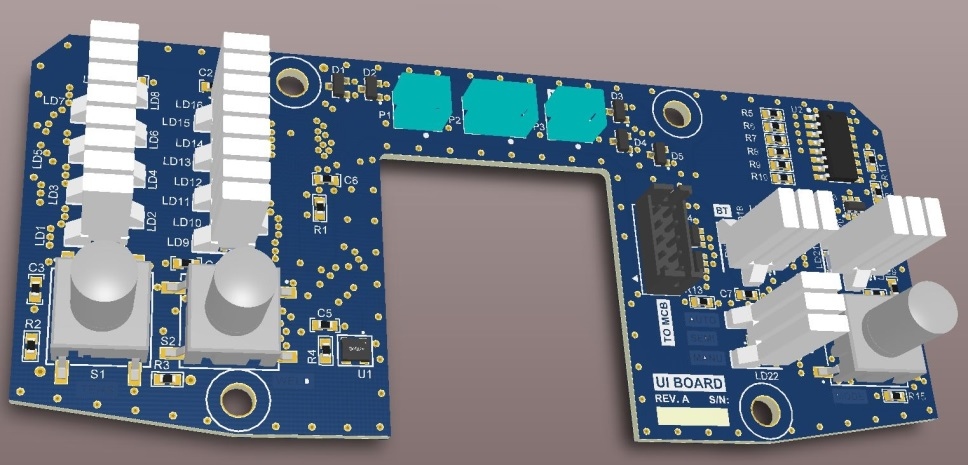
User Interface With Multi-Colored Bar Graphs
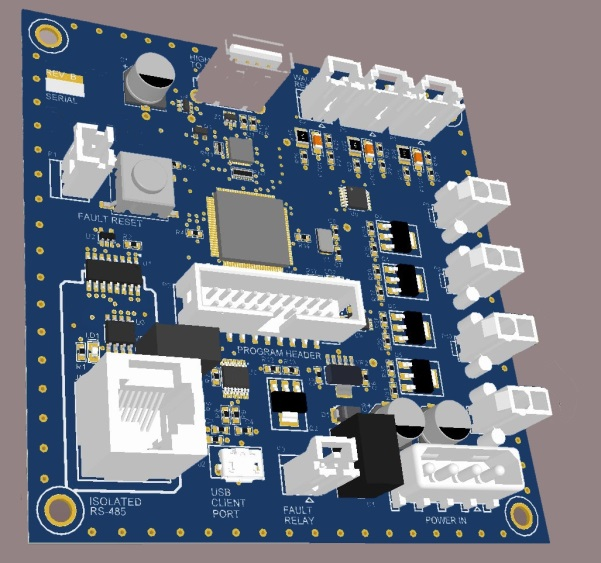
High-Speed 13.56 MHz RFID Reader Controller
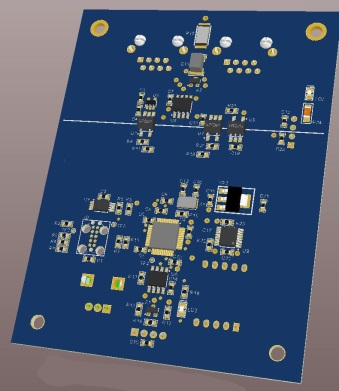
Special-Purpose DMX Interface
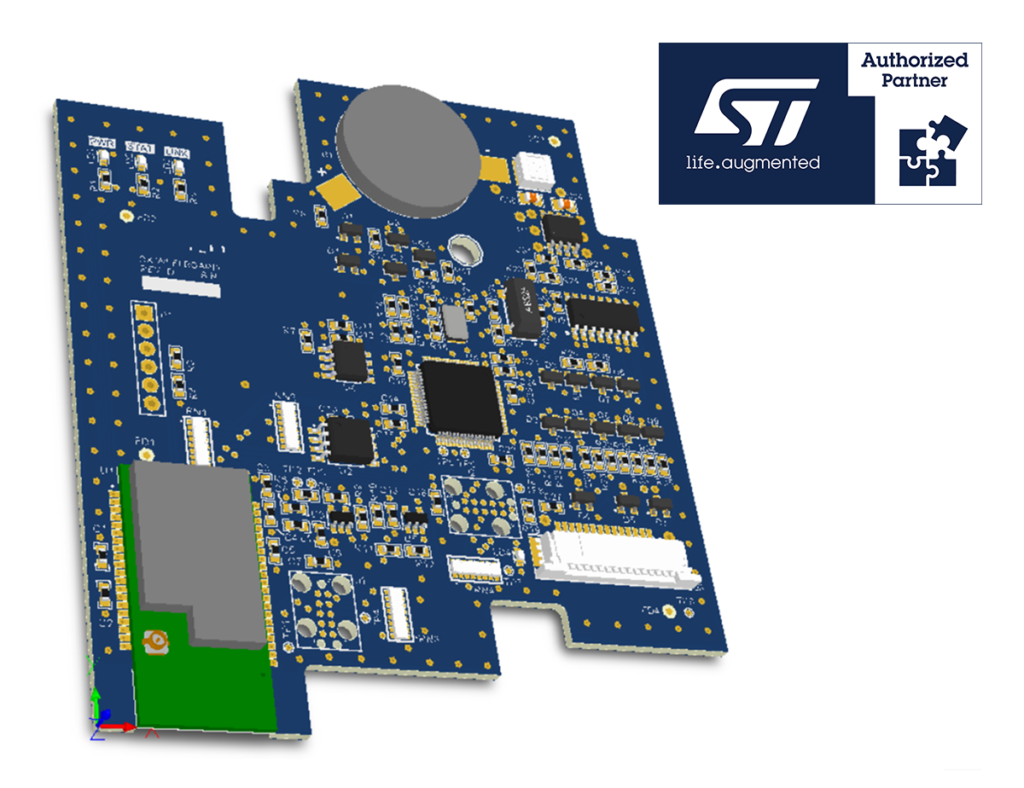
Embedded Wi-Fi Server
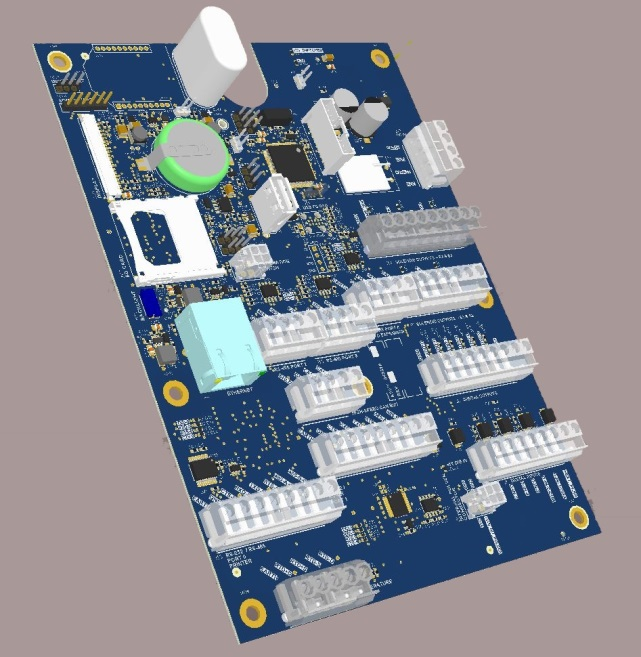
Liquid Metering System

Unattended Point-of-Sale Kiosk Controller
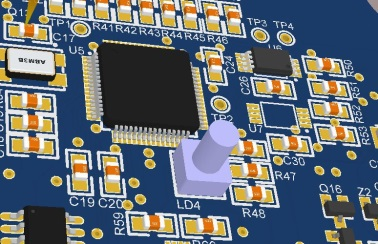
Automotive Data Converter for LIN
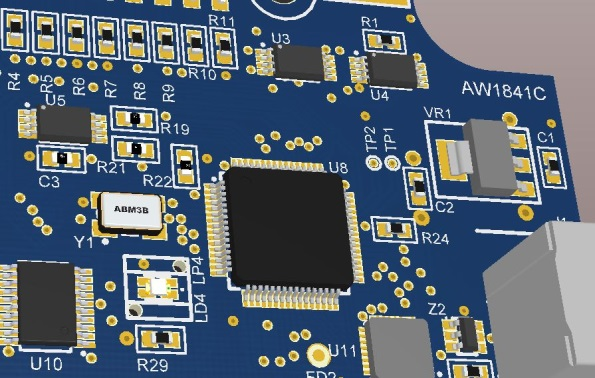
Automotive Data Converter for CAN

4 Channel Optical Signal Processor
One of a series of modules developed for a diagnostic medical instrument, this board uses an STM32F401 microcontroller, running at 84 MHz. Basically a digital signal controller, this ARM® Cortex® M4 integrated circuit includes a 32-bit microcontroller, together with digital signal processor capabilities, including floating-point math, hardware divide, and a MAC (multiply/accumulate) instruction useful for digital filters. This board drives four high-intensity LEDs at programmable current levels up to 350 mA, used to excite fluorescent dyes that indicate the results of a diagnostic biochemical process. This module also receives analog light intensity levels from four external optical sensors which are coupled through optical filters to a 16-bit analog to digital converter. This module is 60 mm square.

3-Channel Stepper Motor Driver
Another in the same series of medical instrument boards, this module drives three stepper motors at programmable current levels up to 1.0A. Each motor is controlled by an STSPIN820 stepper motor controller, which supports up to 256 microsteps. Several of these boards can be installed in the same system, in order to support robotic medical sample handling. The modules in this system are interconnected by a 12V serial bus utilizing an L9613 serial bus interface transceiver. Motors are moved at programmable speeds to positions commanded over the serial bus. Each motor axis supports an optical home switch for position calibration. An STM32F401 microcontroller provides the processing power for this module. This module measures 30 by 96 mm.
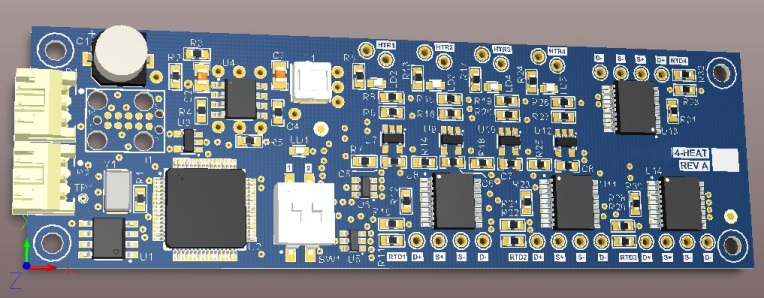
4 Channel Thermal Controller
This module provides controlled power to four resistive heaters, providing closed-loop control of the temperature of diagnostic medical samples at various stages during sample processing. The heaters are driven by VND7NV04 protected power MOSFETs, providing short-circuit protection. Temperature is monitored using platinum RTDs. The firmware running on the STM32F401 microcontroller implements a proportional/integral/derivative (PID) control algorithm to provide quick convergence to each set point temperature, while minimizing over-shoots. The temperature set points are set via the serial bus, but closed loop temperature control is implemented locally to avoid network latencies. The PID parameters are also configurable, allowing tuning to the thermal characteristics of each load. An ST1S40 switching regulator converts 12V system power to the 3.3V levels needed by the microcontroller and associated circuitry. This module measures 30 by 96 mm.

Battery-Operated Power Tool Controller
This circuit board, designed for a battery-operated power tool, drives a powerful brushless DC motor, chosen for its high torque and long product life (as compared to a conventional brushed DC motor). The BLDC motor is sequenced by six STL140N6F7 PowerFlat MOSFET devices, whose small size and high efficiency are ideal for a handheld product. L6398 gate drivers translate the control signals from the STM32F302 microcontroller, an ARM® Cortex® M4 processor, to the voltage levels needed to drive the MOSFETs. An LIS3DH three-axis accelerometer detects mechanical shocks.

User Interface with Multi-Colored Bar Graphs
This is a section of the display module for a handheld power tool. It features a series of RGB (red/green/blue) surface-mount LEDs that illuminate bar graph light pipes. The bar graphs provide a visual indication of the settings that the user has selected, and show power levels dynamically during product operation. Controlled by LED1624GWPTR LED driver ICs, each bar graph segment is individually controllable as to brightness and color—mixing to any color in the rainbow. Normal operating conditions can be shown in green, for example, and error conditions in red on the same bar graph. This provides a bright, attractive, and informative user interface in a compact form factor.

High Speed 13.56 MHz RFID Reader Controller
Our client markets special-purpose system monitoring equipment for high-volume beverage plants. He needed a custom high-speed controller that tracks HF RFID tags at a read rate of over 30 tags a second, and accurately detects any missing tag from a predetermined sequence. We designed a special purpose controller board, based on an STM32F427 microcontroller. It is equipped with a high-speed USB interface, 480 megabits per second, talking to a Feig HF RFID reader. Interfaces to magnetic proximity sensors are included to synchronize the RFID tag monitoring sequence to the moving beverage line. Any RFID error events are communicated over an isolated RS-485 interface to a dedicated laptop, which maintains a log file utilized by plant management to ensure product quality.

Special-Purpose DMX Interface
This lighting control circuit board was designed for a company that designs, manufactures, and markets 1-kilowatt class power supplies for high-intensity lamps that illuminate parking lots and athletic fields. They needed a way to actuate a network of hundreds of lamps that are interconnected using low-cost wiring. This module connects to that network using an isolated RS-485 interface, running at high speed, sending signals over CAT-5 cables for convenient, economical installation. The signal scheme utilized is compatible with the industry standard DMX lighting protocol, allowing each high-intensity lamp to have its brightness controlled individually from a central controller. A cost-effective ARM Cortex M0 processor, the STM32F072C8T6 microcontroller, handles the DMX communications protocol on this module. An ST485 RS-485 transceiver sends control and brightness data to the power controller in the high-intensity lamp.

Embedded Wi-Fi Server
In this system, DiMonte Group embedded a Wi-Fi server into a control board that fits inside an existing point of sale device. The PC board was designed to the same size and shape as the legacy board, which connected via a cable to an expensive custom terminal device. The Wi-Fi module, working in WAP (wireless access point) mode, acts as a virtual short-range Internet, so that any smart phone can act as the controlling device. A field service technician navigates the browser on his smart phone to this Wi-Fi hot spot, and the Wi-Fi module serves web pages to the phone. The smart phone can use Chrome, Safari, Internet Explorer, or other web browser without the need for an Android or iOS app running on the phone. This connection allows the technician to configure the system, access log files, and even reprogram the firmware in this and in all the other embedded modules that are interconnected within the system. This board is based on an STM32F401 ARM Cortex M4 microcontroller. The FCC-approved Wi-Fi module contains another STM32 ARM Cortex M4 processor controlling an 802.11 b/g/n radio.

Liquid Metering System
Our client is a manufacturer of highly accurate metering systems for fluid delivery. They decided to upgrade their systems to provide contemporary control surfaces, including a large, high-resolution touchscreen display running a GUI (graphical user interface). Also added is a wireless interface to a peripheral device. DiMonte Group helped develop the electronics for both the metering side, and the remote terminal. On the main board, we were able to compress the existing I/O circuitry, making space to incorporate a Variscite SOM (System on Module) with a 1 GHz ARM Cortex A9 processor running Linux. The SOM runs the GUI (graphical user interface), while an STM32F446 ARM Cortex M4 microcontroller controls the real-time I/O. This architecture is increasingly popular in industrial systems we have worked on—a Linux- or Windows-based single board computer for the GUI, joined up with an ARM Cortex M microcontroller to handle the low-latency, real-time tasks that the GUI-centric OS systems cannot readily handle.

Unattended Point-of-Sale Kiosk Controller
This client sells rugged kiosks that are consumer-facing, allowing a customer to purchase a service in unattended mode. Within the kiosk are point-of-sale modules for handling credit cards and cash, and for making change, all interconnected using multiple POS industry-standard serial data interfaces. The board we developed replaced a legacy system, which was based on an older under-powered single board computer, with a Raspberry Pi. The RPi 3B features a Broadcom ARM Cortex A53 processor, operating at 1.2 GHz, running Linux. We included an STM32F072 ARM Cortex M0 microcontroller for handling power mode control, some of the POS serial interfaces, and other real-time tasks.
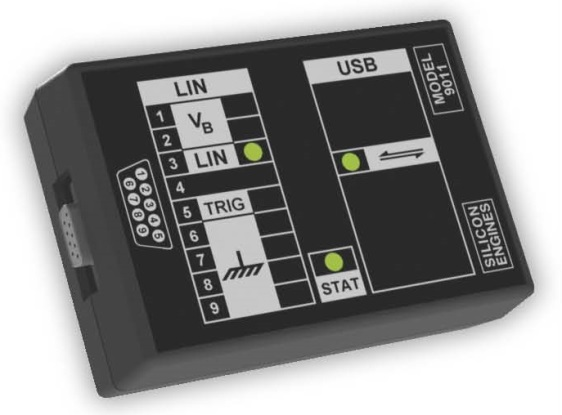
Automotive Data Converter for LIN
Designed for automotive design and test engineers, this product allows a laptop PC to talk to automotive modules that communicate using LIN, the Local Interconnect Network. Includes an STM32F103 microcontroller with firmware developed by our engineers that implements the LIN protocol. Programmable to run LIN at any integer data rate from 1,000 to 21,000 bps. Connects to a laptop using USB.
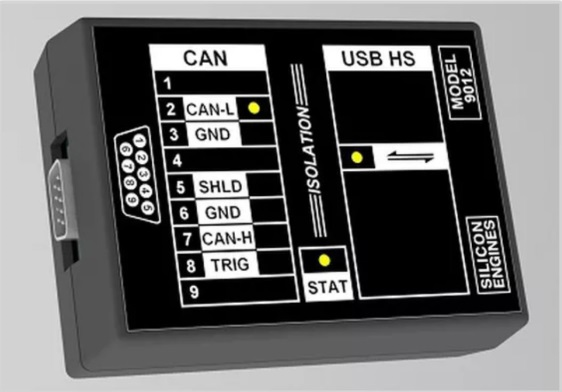
Automotive Data Converter for CAN
This converter interfaces to the CAN (Controller Area Network) bus found in cars, trucks, off-the-road vehicles, and industrial applications. Supports high-speed USB connected to a PC, and CAN at data rates up to 1 megabit per second. Owing to the high-speed USB data rate (480 megabits per second), and optimized firmware, written by our engineers, that runs on an STM32F205 microcontroller, this device guarantees no dropped bus traffic at 100% CAN bus utilization at 1 megabit per second. Features full electrical isolation between the CAN side and the USB side. A Windows dashboard is included.

